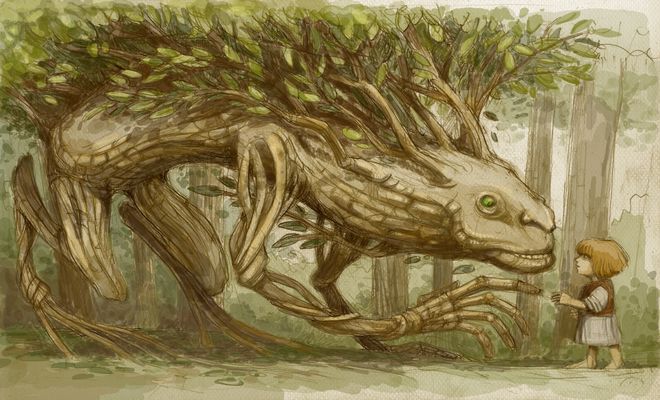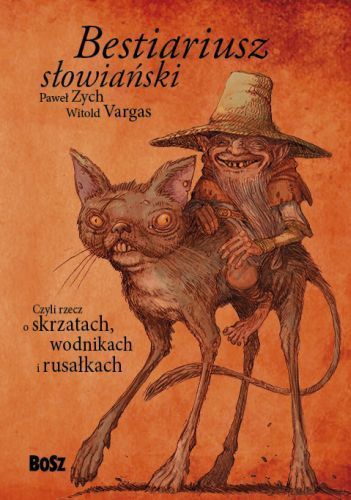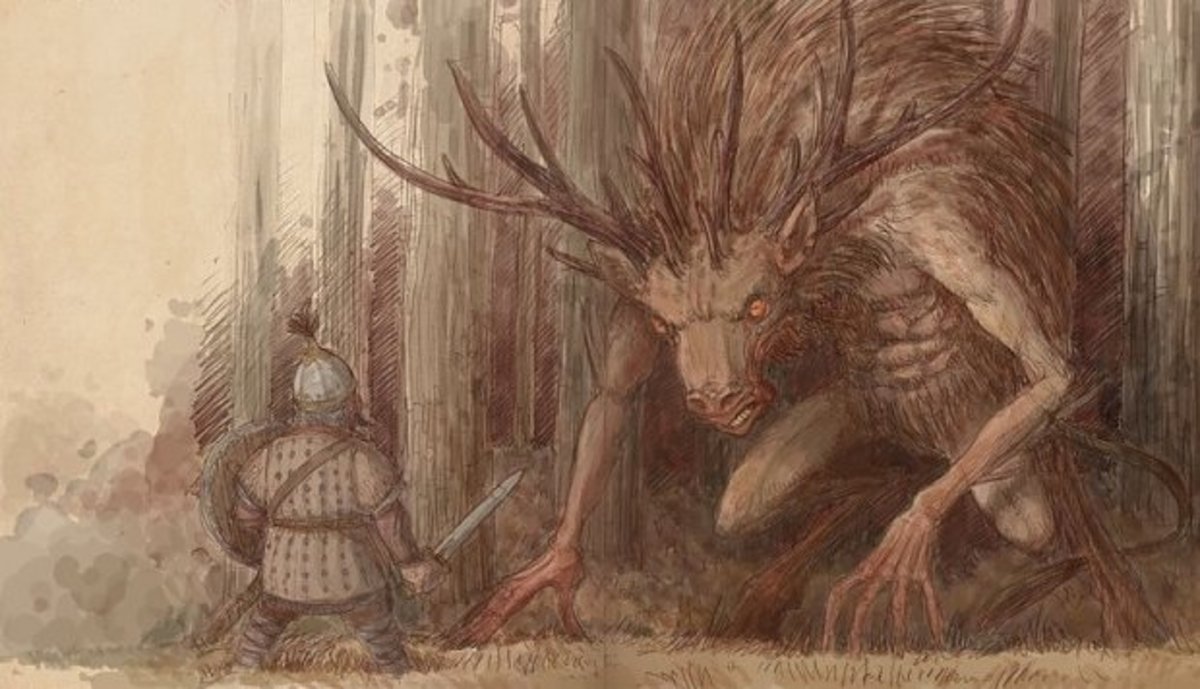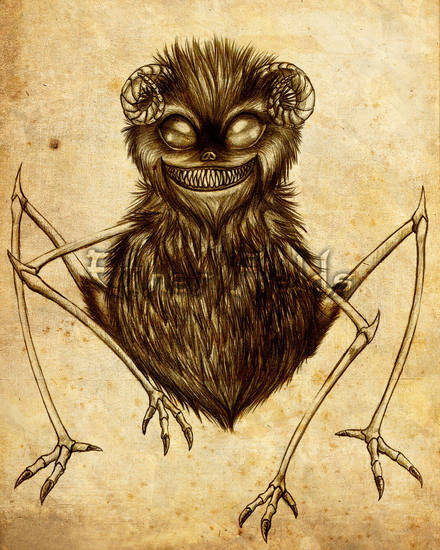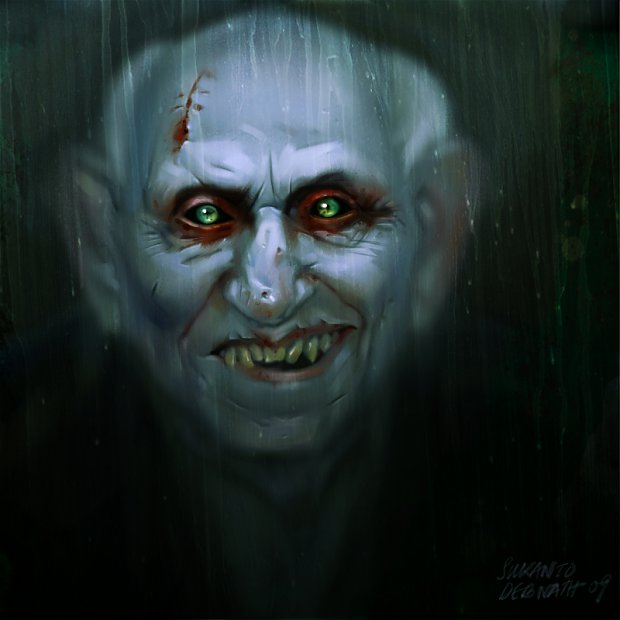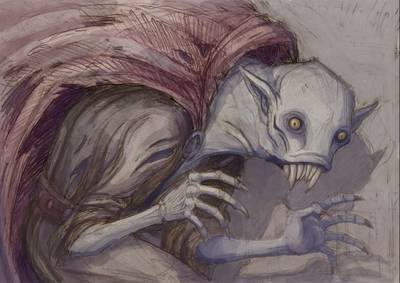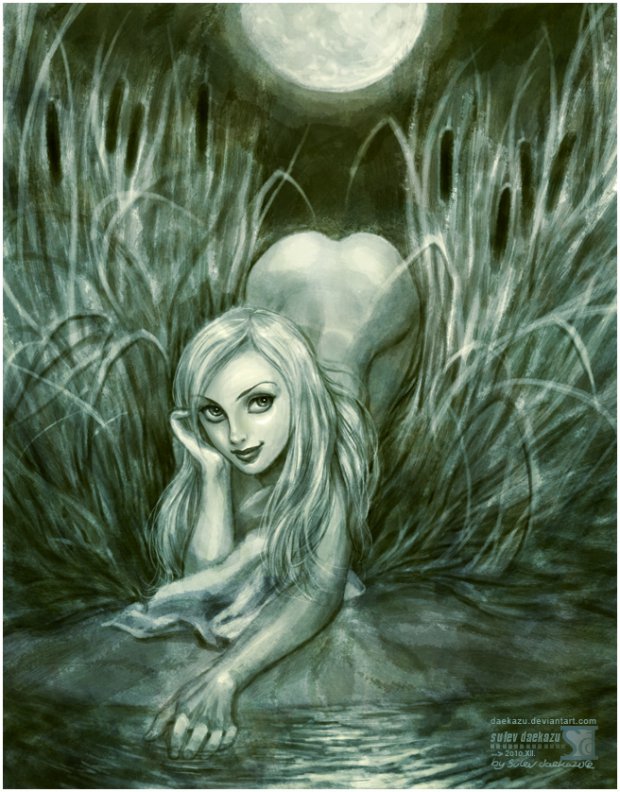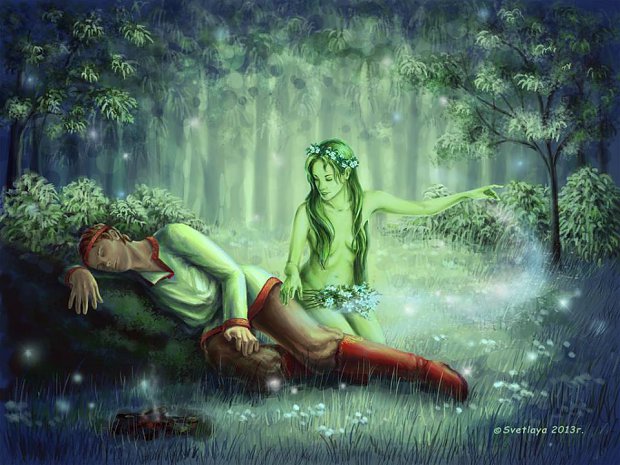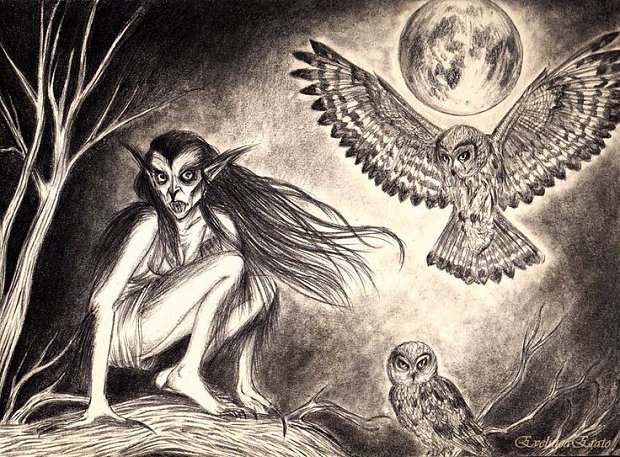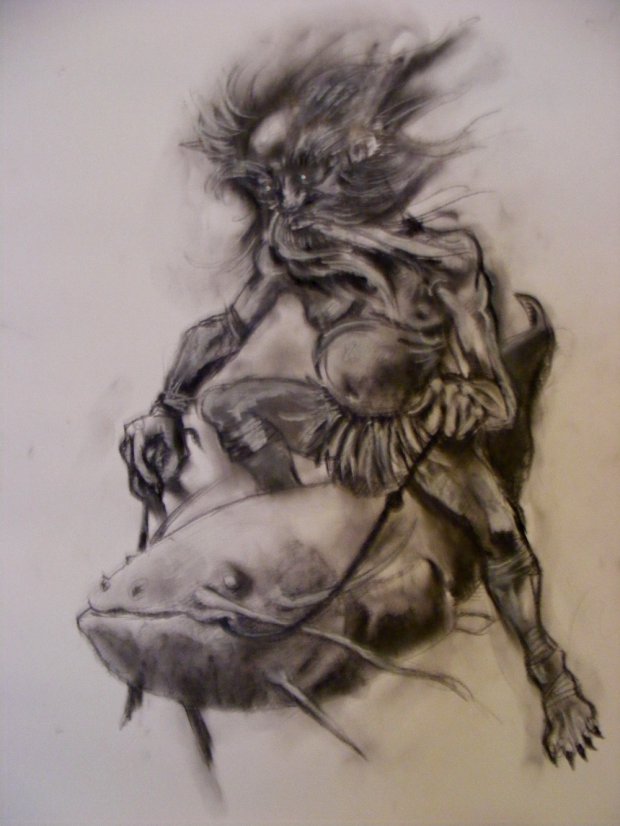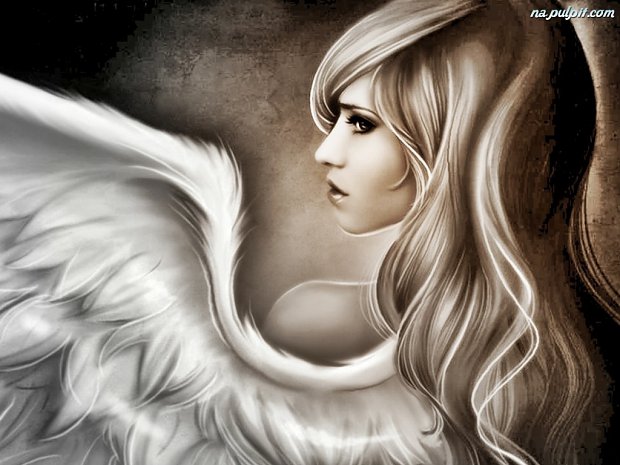Post by Bonobo on Jan 18, 2022 12:33:32 GMT 1
An interesting article about Slavic demons.
Unfortunately, the translator proved helpless at times and twisted or left certain unusual words in the original form.
www.onet.pl/informacje/histmag/wampiry-ubozeta-poludnice-zyry-slowianska-demonologia-ludowa-podbija-swiat-popkultury/j302wkm,30bc1058
Vampires, poorlings, noons, gyrs - Slavic folk demonology conquers the world of pop culture
Slavic folk demonology is experiencing a kind of renaissance. It has strong connections with primal, pagan beliefs and is one of the topics more willingly exploited by pop culture. Vampires, noons and the poorlings are the heroes of not only contemporary literature, but also film.
Magdalena Mikrut-Majeranek
1.2 thousand
January 8, 2022, 13:52
As Erik Davis, author of the book "TechGnosis: Myth, Magic + Mysticism in the Information Age" notes, now "(...) pagan and paranormal things have colonized the spheres of darkness in popular media." According to Anna Czekanowska, an ethnomusicologist and cultural anthropologist, "we constantly relate to tradition today despite - or perhaps precisely in the face of - rapid transformations". It is the point of reference, a kind of anchor. It can be treated as the basis of illusory ideas, as well as memories of things, people and phenomena that no longer exist. And demonology is a never-ending source of inspiration.
Dziwożona [mamuna] - Jan Styfi (1839–1921) after Henryk PillatiDziwożona [mamuna] - Jan Styfi (1839–1921) according to Henryk Pillati - Domena publiczna / Historical portal Histmag.org
As Erik Davis writes, "the virtual topography of our millennium world is filled with angels and aliens, digital avatars and mystical minds of gaia. Utopian longings and gnostic scientific fantasies, dark premonitions of apocalypse and demonological magic. These objects float on the rising and falling waves of media fashions, advertisements. and economic activity, and some of them are already disappearing into an increasingly market-dominated information culture. "
Demonology is a product of man, as demonstrated by Leonard Pełka. It was our imagination that brought to life a galaxy of fantastic creatures, among which the author distinguishes, among others: angels, demons, cyclops, devils, goblins, elves, fauna, gnomes, nymphs, parks, mermaids, drowners, the poor, werewolves and nightmares. According to Pełka, "the void of the unknown has been filled with creations of human imagination". Man fills the world around him with fantasy products, which is aimed at getting used to the world and the world, enchanting space. Initially, he identified demonic beings with unexplained and repeatedly terrifying natural phenomena. Each phenomenon was assigned a magical creature responsible for it, creating a specific hierarchy of demons. The old beliefs played an integrating role for rural communities.
They also contributed to the development of a sense of social distinctiveness of individual communities. The domination of Christianity over Slavic beliefs led to the assimilation of two separate religious systems. As a result of the process of interpenetration of Christian themes with mythological thinking, a new system of thinking was crystallized and Slavic-Christian demonic images and corresponding magical-religious practices arose. If you want to get acquainted with Slavic folk demonology, it is worth referring to the classics, ie "Mythology of the Slavs" by Aleksander Gieysztor and "Polish People's Demonology" by Leonard J. Pełka.
According to Leonard Pełka, demonic beliefs occupy an important place in Polish folk culture, because in the archetype of Slavic folk cultures there are tendencies to mythological and symbolic personification of various phenomena and processes that take place in the natural and social environment of man. Over the years, the demonic images have evolved and standardized. Along with the change in the socio-production and cultural conditions of life, the spiritual culture of the inhabitants of Poland, as well as the system of values and social norms, also changed. Some of the beliefs, however, have been preserved in a relic form in verbal folklore, i.e. in stories, legends, fairy tales or proverbs, and in folk art.
ADVERTISEMENT
Culture and folklore have been supporting the heritage of folk magic and secret science since the Middle Ages. Popular witches, werewolves and ghouls were hosted both in folk demonology and in various types of songs, and today the knowledge about them is stimulated by the media. In the past, these motifs were popularized by fair-fair literature, and today by audiovisual productions. Leonard Pełka in the 1980s wrote about the social need to show forgotten fragments of the cultural heritage of Poles, which undoubtedly includes folk demonology. He appealed: "it is necessary to save from oblivion this fabulous world of demonic images of our forefathers and preserve his image for posterity". The film industry responded successfully to this appeal.
How do you recognize a demon?
How did our ancestors recognize demons? The Polish medieval historian, Aleksander Gieysztor, distinguished several constitutive features characterizing demons, and these are: temporary invisibility, dark or red color of the skin, fiery and sparkling, as well as short stature, abundant hair, thick eyebrows, unusually large head, enormous eyes, intriguing teeth, profuse lips, excess fingers, lameness, and animal or bird feet.
These creatures were also believed to have the ability to metamorphose into an animal or bird. In folk demonology, there is a division of supernatural beings into guardians of the elements: heaven, fire, water, air, dispute and earth, and the masters of fields, forest and wild game, crops, herds, home, family and tribe, fate, treasures, minerals, love and lust. , virtues, truths and order. There are also the spirits of weather and the moon spirits, as well as heralds and carriers of disease and death.
Ivan Bilibin, AquariusIwan Bilibin, Wodnik - Domena publiczna / Portal historical Histmag.org
Południce, Drownce, Upiory? What creatures inhabit the world of ancient beliefs? The classification of supernatural beings can be found in the publication "Polish folk demonology" by Leonard J. Pełka. The author divides them into:
- demonic personification of atmospheric phenomena (demonology of winds and whirlpools, demons of storm and hail clouds),
- demonic personification of natural phenomena (water, coastal, mud, field, forest, mountain and underground demons),
ADVERTISEMENT
- demonic personification of the phenomena of social life (caring home demonology: demonic creatures of a pejorative nature, e.g. trunks, elves, squawks, dragons, giving favors to people in exchange for their souls, demonic creatures, such as chobołdy or dwarfs, taking care of people and their the farm due to his own whim, guardian angels),
- negative demonology - demonic and semi-demonic creatures disturbing the prevailing harmony, violating the rhythm of the functioning of human societies,
- demons harming obstetricians and kidnapping babies (devils, demons choking people and sucking blood from them, witches, demons of disease and death, werewolves, demons tormenting farm animals)
- and parademonic phenomena (fears, called as "something", disturbing a man and causing him fear, phantoms and phantoms (phantoms) in the form of a woman, knight, monk, or taking the animal shapes of a black dog or horse, characterized by a neutral attitude to human). The paradormal phenomena include: "Black Lady" from Lesko, "Mała Pani" from Odrzykoń, "White Lady" from Niedzica, "Black Dog" from Ogrodzieniec or "Crazy Baron" from Ryczów.
Ludwik Stomma pointed out that in folk culture there is a connection between those who died tragically and their transformation into demons. The scientist collected material (chronicle records from the second half of the 19th century) concerning 500 cases of ghost demons. After the analysis, it turned out that as much as 20.2 percent. are drowned people, 18 percent. - unbaptized children, 16.6% are killers and hangmen, while 11 percent. are porońki, and 8 percent. they died on their wedding day. It has also been shown that a minimal percentage of transformations into demons is formed among people who died violently, or from stillbirths, or women who died during or immediately after puerperium.
This analysis also shows that the dead tragically turned into demons in order to avenge their fate, which is why they showed a decidedly hostile attitude towards the living. Ludwik Stomma believes that people who died in a marginal state, or those who died and did not perform the appropriate rituals and rituals related to their death, constitute a group called the dead-undead, which do not belong to any specific place, and therefore become demons . According to the scholar, they become "creatures belonging nowhere, unable to fit into this or that world". This group includes "the souls of suicides, hangmen, other violent deaths; people who had two hearts, two rows of teeth, and so on."
ADVERTISEMENT
The ethnologist has divided fantasy creatures into five separate categories. The first of them includes all the characters adopted from the Christian tradition, as well as those known from itinerant threads, whose origin is unknown. These characters were assimilated and transformed to correspond to texts typical of folk culture. Therefore, the first group includes, among others: angel, basilisk, devil, griffin or dragon. The second category is made up of all personified natural disasters and natural phenomena, i.e. poverty, disease, destiny, death, plague.
The third group includes living people, who are usually credited with having supernatural properties and connections with the world of demons. These are, for example: characters, witches, misziysznyki, plateaus (the film "Wet fairy tale", directed by Wojciech Gierłowski), beetle-eaters, werewolves, nightmares. The fourth category is made up of malicious or helpful creatures who can be combined with non-agricultural activities - so they include: the treasurer, the Szarlej or the poor. Stomma argued that in folk beliefs, people who engaged in activities not related to agriculture were associated with demonic forces.
Philip Burne-Jones, Vampire, 1897Philip Burne-Jones, Wampir, 1897 r. - Domena publiczna / Portal historical Histmag.org
He also cited stories about devils helping millers in times of drought to propel water to the mill wheel and driving waves away from the mill during floods. On the other hand, for example, thieves owe the possibility of becoming invisible and noiseless to demons after taking an appropriate agent, made of a dried vein extracted from a corpse.
The last, fifth group are characters who are the incarnation of dead people. Among them, you can distinguish such figures as:
- Baba Yaga, who is the soul of a woman who died during childbirth,
- she-wanderer - a hangman, non-baptized or deceased during confirmation,
- tenant - associated with the spirits of ancestors,
- leprechaun - soul of a deceased fetus or a mare,
- mamuna - the soul of a woman who died during pregnancy or during the puerperium (film "Abortions", dir. Brandon Christensen),
- nawka - a woman died during a wedding,
- firefly - the soul of a dishonest geometry,
- she-noon - souls belonging to the engaged who died before their own wedding,
- rusałka - non-baptized, died before the wedding,
- rokita - the soul of a suicide or a murdered person,
- troublemaker - a soul belonging to a dead fetus, abortion or non-baptized person,
- drowner - the soul of a drowned person,
- the apparition - the soul of the murdered
- and a ghost demon - a soul belonging to a suicide, a hanged man, or a deceased person who was killed in another way, or people who have duplicate organs, e.g. a heart or two rows of teeth.
Nosferatu - a photo of the title characterNosferatu - a photo of the title character - Domena publiczna / Portal historical Histmag.org
The Slavs believed in domestic guardian demons, which had to be respected. Giraffes, next to halflings, the poor, bylice-rockers, meridians and dwarfs are classified as domestic and farm creatures. They are classified as Bida's servants. Legends report that they are nasty, small in size, spherical in shape and black in color. To move around, they use two thin limbs that resemble chicken legs. On the other hand, they eat with the help of two grasping, clawed and wrinkled paws. They do not have a separate head and torso as they do not have a neck.
They have round and mobile eyes that glow like black carbides. They are characterized by an enormous maw absorbing everything that is within their reach into the gravel mouth. The girs do not have a permanent place of residence because they wander from hut to hut, destroying the crops and eating the crops accumulated by the farmer. In turn, the poor are considered house keepers and guards. The term poor can be found in texts from the 15th century. This word was recorded in the sermon, and the fragment of interest to us reads:
"There are those ... who make sacrifices to demons, who are called poor, leaving them with scraps of food on Thursday after lunch ... There are some who do not wash their bowls after dinner on Holy Thursday, to feed the souls and other spirits, who are called poor, believing foolishly that the spirit needs carnal things "(after: Stanisław Urbańczyk, Dawni Słowianie. Faith and worship (Wrocław-Warsaw-Kraków: Ossoliński National Institute, 1991, p. 51).
In the 17th century, their meaning changed, because the poor were then called poor, little creatures who were credited with wanting to help people in their hard work. They helped, but not selflessly. They had to be left with food. Although the faith in the poor has passed, we can find them in the novel "Whisper" by Katarzyna Berenika Miszczuk.
Vampire and his cultural incarnations
One of the most popular creatures used by popular culture is the vampire. The vampire myth, as admitted by Dr. Katarzyna Kaczor, cultural scientist and author of the publication "From Dracula to Lestat. Vampire Portraits": "is very old, appears in the Greek and Roman traditions, and literary traces lead to pre-Christian beliefs of the Slavs, only in the nineteenth century does he enter the sphere of pop culture" . Why? Zygmunt Bauman in the publication "Mortality and immortality. On the multiplicity of life strategies" proves that death, apart from its destructive function, also plays a causative role. It created the foundations for the development of culture.
In the above work, Bauman also develops the problem of achieving immortality. In his opinion, culture frees us from death and takes us to immortality. With its help, people extend their lives and delay death. A vampire, in turn, is an immortal being, a living corpse, and the possibility of extending existence proves to be tempting to many. The vampire that is popular today, according to the beliefs of the Slavs, was called a phantom, a wąpierza, a vampire or a hairdresser. Erberto Petoia, author of the publication “Vampires and Werewolves. Sources of history, legends from antiquity to the present day ”, which refers to the researcher and folklorist Agnes Murgoci, lists three types of vampires: a dead vampire, a living vampire and a varcolac, so a vampire swallowing the moon and sun during an eclipse.
Vlad the Impaler in an oil painting by an unknown artist, second half of the 16th centuryVlad the Impaler in an oil painting by an unknown artist, second half of the 16th century - Domena publiczna / Portal historical Histmag.org
The vampire's career in culture began with the publication of the 19th-century Gothic novel by Bram Stocker. The second inspiration to create the creation of a vampire was the figure of the Romanian Wallachian hospodar, vassal Maciej Corvinus, Vlad III the Impaler, known as Vlad Tepesz, who lived in the 15th century. He was famous for his enormous cruelty and was to be called Dracula, because his father, Vlad II, was nicknamed the Devil (drac), because he fought in the ranks of the Knight's Order of the Dragon. Matei Cazacu, a French medieval historian of Romanian origin, explains that the Latin word "draco", from which Romanian "drac" is derived, means "devil". Thus, the nickname "Dracul" should mean the devil, while "Dracula" - "son of the devil". A slightly different interpretation is provided by Maria Janion (a historian of literature, ideas and imagination, and literary critic), who wrote that Dracula literally means the son of the one named Dracul.
After the book, the next step on the way to popularize the vampire myth was the film "Nosferatu, a symphony of horror", made in 1922 by Friedrich Wilhelm Murnau. The year 1931 brought another painting of "Dracula - King of the Living Dead" by Tod Browning. The cinema's romance with the vampire myth continues to this day.
Initially, vampires were portrayed as bloodthirsty beasts inhabiting inaccessible castles and waiting for defenseless people. Movie vampires living in gothic castles usually waste their time at feasts, orgies and endless attacks, hunts and murders. In the 1970s, there was a break with the "safe fear" cinema. From that moment, you can observe an evolution in the media creation of a vampire. The evolution happened with the appearance of the film, which is a remake of "Nosferatu" by Werner Herzog. Then the leitmotif of fear was replaced with loneliness. The vampire was humanized by the aforementioned director.
This is not the end of changes. In the 1990s, a new type of bloodsucker appeared: the lover-vamp. Thanks to the movie "Dracula" by Francis Ford Coppola, the monster turned into a romantic lover. Another image change took place in "Interview with the Vampire" by Neil Jordan. This time, the creators presented the vampire in a stylish edition, rich, handsome. According to Katarzyna Kaczor, this film is an example of the fact that "vampires pretend to be people, when they pretend to be vampires" .
In the 21st century, a vampire hungry for love entered the scene. Books, movies and TV series began to tell imaginary stories about the feeling between mortals and vampires, about the fights of vampire families and the desire to dominate the world. There are also Polish film vampires by Machulski, who eagerly fulfill the postulate of Alberti and Franklin, ordering them to lead a modest and hard-working life. The Makarewiczs are an example of "virtuous" bloodsuckers, incapable of murder. Similarly, the Cullens from "Twilight", belonging to the class of modern, elegant, American vampires, although they are forced to fight other vampire families and tribes that threaten America and the life of one of them.
Audiovisual productions also deal with the issue of a man's metamorphosis into a vampire as a result of being bitten by another vampire. This is not the only way, in the movie "The Vampire's Assistant" (Cirque du Freak: The Vampire's Assistant), the main character, a vampire, wants to save a friend who has been bitten by a poisonous spider, cuts the skin on his finger, and then injures the boy and then hands intertwine, the outflowing blood connects their souls with an unbreakable knot. The boy slowly turns into a vampire ...
What is the attraction of a vampire?
Miodrag Bulatvić, a literary scholar and writer, believes that humanity cannot live without a vampire. Representatives of bloodsuckers became full-time heroes of films and series. We can find vampires, among others in such productions as: "Nosferatu - a symphony of horror", "Dracula - the king of the living dead", "The Mark of The Vampire", "Horror of Dracula", "Fearless vampire killers", "Nosferatu Vampire", "Interview with the vampire" , "Lullaby", "Twilight", "Vampire's Assistant", "Queen of the Damned", "Underworld", "Van Helsing", "Blade", "Let me in", "Hotel Transylvania", or in the series: "Buffy: Vampire Terror "," Angel of Darkness "," Pure Blood "," The Vampire Diaries ",
But how much vampire is left in a vampire trimmed by pop culture? Few. Gilles Menegallo, the writer, claims that "the trivialization of the figure of a vampire who" humanizes "loses his status of being different, enigmatic and terrifying . " Despite this, the filmmakers are still trying to maintain the image of the vampire as a supernatural, different and dangerous being. However, more and more often his individuality is taken away, forcing a human being of flesh and blood into the world.
Południca is the hero of folk songs
Demonology is present not only on the big screen or in popular series. Its elements have also been instilled in other areas of popular culture. An example of the interpenetration of the literary sphere with demonology is the music created by the Polish folk band Żywiołak . One of their songs - "Świdryga i Midryga", inspired by Leśmian's poem "Świdryga i Midryga" from the volume "Łąka", treats, among others , about the meridian, as indicated by the line: "The Pale Meridian jumped them in the sun. And Shmidriga and Midriga and the dance council".
In turn, in the song "Południca" by the Merkfolk band, playing folk metal, there is such a fragment:
"Arrives at noon
Where the ear is born
The specter of the bride
It tempts with its beauty
It swirls among the grain
Which he holds
watch out for her
Let her not deceive you "
This motif is also present in the film "Południca" (directed by Jiri Sádek, Matej Chlupacek). Południki also appear, among others, in on the pages of the novel "Flower Fern" by Katarzyna Berenika Miszczuk. As the 19th-century ethnographer Oskar Kolberg, a Polish ethnographer, folklorist and musicologist, wrote, these creatures were known in the 19th century in the Lemko region. They were referred to there as "field virgins" and were characterized as having blue eyes and fawn hair decorated with ears of corn and cornflower.
They were ascribed slightly different characteristics in each part of the country. And so, for example, in Łęczyca it was believed that they had huge, blood-red lips and a long red tongue, and instead of hair - weeds. In turn, in Podlasie and Mazovia it was said that they resembled death. Kolberg points out that in Małopolska, the midday was imagined as a tall and extremely ugly woman with white robes. The demonic being was always accompanied by seven black dogs. It was believed that at noon these rye baboons were kept in grain and peas. The poopers rattled the dogs of the people who entered the fields. People working or resting in the fields in the hottest heat also stalked them. They sent headaches (sunstroke), infirmity, and even death to the insubordinate daredevils who did not have sufficient respect before them.
As Gieysztor points out, they were to be seen "from the Holy Trinity to the Holy Peter". After the harvest, they were to hide underground and hibernate. It was also believed that they could devour children or bury them alive in the ground. According to other accounts, known in Silesia, they tormented them to death with questions about flax. In turn, the children asked difficult riddles. Initially, noon was considered a guardian demon of cereal vegetation. A little later, the image of the meridian was enriched with threads of atmospheric beliefs. It was then that they began to be credited with the effect of waving cereal fields or bringing whirlpools.
As Leonard Pełka concludes, the thread of atmospheric beliefs was reinforced by the belief that the meridians personify the dangers of staying in the field for too long during hot and sunny summer days.
Béla Lugosi as DraculaBéla Lugosi as Drakula - Domena publiczna / Portal historical Histmag.org
Wiły appear in another Żywiołak's song. The first chronicle records about these creatures were already known in Old Russian church texts, which were written at the turn of the 11th and 12th centuries. However, in the Balkans, they did not appear until the 13th century. A completely different meaning of the word "wiła" appears in the Western Slavs, who identify it with a man without reason, a madman and a jester. The very word "wiła" implies mobility.
ADVERTISEMENT
According to the beliefs of Wiła, they serve the Lady of the Forest, Lesza-Wile, who is the wife and sister of Lord Boru - Borowiła. Their tasks include: bringing clouds, chasing rains, initiating storms and calming atmospheric phenomena. According to beliefs, they were to invite winds-howls to the forest, with which they danced until they dropped. During their dance, they form a magic circle that must not be interrupted. Any daredevil who decides to disturb the cosmic order must be ready to die, because when he runs away, Wiła will catch up with him and kill him with one arrow. The bow is their attribute because they love hunting, which they often go to in the company of Boruta and Borowił.
Gieysztor believes that the souls of girls or young married women who did not enjoy their lives turn into Wiła. In his opinion, these creatures are beautiful and naked women with fiery eyes, charming men. Wiły were believed to have unusually long hair, shimmering with many shades of red. These creatures wrap their hair around their slender and naked body. Additionally, they have elongated and transparent wings resembling dragonflies.
Their skin is extremely white, while the neck is very long, resembling a swan. For this reason, the swan is the animal most often chosen by them, which they turn into during metamorphosis. Gieysztor also mentions that, apart from the swan, they often take the form of a falcon or a horse. He also adds that their relationships with people are possible.
Wiły often have intercourse with young men who are lured to the clearing. On the other hand, if a man wants to catch Wiła and marry her, he must do so when he takes a bath, because only then does he take off his magic wings, which contain the power. Children born of Wiła's relationship with a living man will achieve incredible success. The son will become a prince, hunter or a famous hero, while the daughter will be a prophetess or sacrifice.
Unfortunately, the husband will not be happy with his wife-Wiła, because when his affection for his wife reaches its apogee, she will leave him and pass away, but he will soon die of loneliness and longing. Wires are featured in The Elder Scrolls V: Skyrim. Wiły (Willids) also appear in Giacomo Puccini's opera "Wiły", the libretto of which was based on a short story by Jean Baptiste Alphonse Karr of the same title.
Why are the characters from Slavic demonology so popular?
Transylvania, 1961, photo: Fortepan, CC BY-SA 3.0Transylvania, 1961, photo: Fortepan, CC BY-SA 3.0 - Fortepan / Historical portal Histmag.org
Ugliness attracts and fascinates us. The popularity of demonological themes, which are manifested in products of modern popular culture, can be explained by the fact that the media use the primal power of irrationalism. They are based on our fears and dreams awakened by writers and filmmakers. Erik Davis admits that the old phantasms and metaphysical longings have not completely disappeared. Contrary to the narrative that "technology has helped banish magic from the world by forcing ancient, inherited networks of symbols to yield to clear, secular projects of economic development, skeptical research, and material progress ." Old fantasies and dreams have undergone a major metamorphosis, changing their character, or have gone, as Davis writes, underground, where they work their way to the cultural, psychological and mythological motivations that organize the modern world.
Bibliography:
Z. Bauman, Mortality and immortality. On the Multiple Life Strategies, transl. Leśniewska N., Warsaw 1998.
Baranowski B., In the circle of ghosts and werewolves, Łódź 1981.
G. Bataille, Transgresje [in:] Historia erotyzmu, Kraków 1992.
E. Davis, TechGnosis. Myth, Magic + Mysticism in the Information Age, Poznań 2002.
A. Czekanowska, Traditional cultures versus the present day. Music, poetry, dance. Warsaw 2008.
A. Gieysztor, The Mythology of the Slavs. Artistic and Film Publishers, Warsaw 1982.
M. Janion, The Vampire. Symbolic biography, Gdańsk 2008.
K. Kaczor, From Dracula to Lestat. Vampire Portraits, Gdańsk 2010.
Kolberg O., All Works. Materials for the ethnography of Western and Southern Slavs. T III, Southern Slavic Region, Poznań 2001.
P. Kowalski, Zwierzoczłekoupiry, vampires and other beasts, Krakow 2000.
L. Pełka, Polish folk demonology, Warsaw 1987.
E. Petoia, Transylvania, land of vampires [in:] Vampires and werewolves. Sources of history, legends from antiquity to the present day, Kraków, 2003, p. 173 [after:] A. Murgoci, The Vampire in Roumania, "Folklore", London 1926, pp. 321,322, 329.
L. Stomma, Anthropology of the culture of the Polish countryside of the nineteenth century, Warsaw 1986.
Father Woźniak, Vampire is in all of us [in:] "Przekrój" of 18 May 2010, No. 20/3386.
Editing: Mateusz Balcerkiewicz
Source:
Historical portal Histmag.org
Date Created: January 8, 2022, 13:52

Unfortunately, the translator proved helpless at times and twisted or left certain unusual words in the original form.
www.onet.pl/informacje/histmag/wampiry-ubozeta-poludnice-zyry-slowianska-demonologia-ludowa-podbija-swiat-popkultury/j302wkm,30bc1058
Vampires, poorlings, noons, gyrs - Slavic folk demonology conquers the world of pop culture
Slavic folk demonology is experiencing a kind of renaissance. It has strong connections with primal, pagan beliefs and is one of the topics more willingly exploited by pop culture. Vampires, noons and the poorlings are the heroes of not only contemporary literature, but also film.
Magdalena Mikrut-Majeranek
1.2 thousand
January 8, 2022, 13:52
As Erik Davis, author of the book "TechGnosis: Myth, Magic + Mysticism in the Information Age" notes, now "(...) pagan and paranormal things have colonized the spheres of darkness in popular media." According to Anna Czekanowska, an ethnomusicologist and cultural anthropologist, "we constantly relate to tradition today despite - or perhaps precisely in the face of - rapid transformations". It is the point of reference, a kind of anchor. It can be treated as the basis of illusory ideas, as well as memories of things, people and phenomena that no longer exist. And demonology is a never-ending source of inspiration.
Dziwożona [mamuna] - Jan Styfi (1839–1921) after Henryk PillatiDziwożona [mamuna] - Jan Styfi (1839–1921) according to Henryk Pillati - Domena publiczna / Historical portal Histmag.org
As Erik Davis writes, "the virtual topography of our millennium world is filled with angels and aliens, digital avatars and mystical minds of gaia. Utopian longings and gnostic scientific fantasies, dark premonitions of apocalypse and demonological magic. These objects float on the rising and falling waves of media fashions, advertisements. and economic activity, and some of them are already disappearing into an increasingly market-dominated information culture. "
Demonology is a product of man, as demonstrated by Leonard Pełka. It was our imagination that brought to life a galaxy of fantastic creatures, among which the author distinguishes, among others: angels, demons, cyclops, devils, goblins, elves, fauna, gnomes, nymphs, parks, mermaids, drowners, the poor, werewolves and nightmares. According to Pełka, "the void of the unknown has been filled with creations of human imagination". Man fills the world around him with fantasy products, which is aimed at getting used to the world and the world, enchanting space. Initially, he identified demonic beings with unexplained and repeatedly terrifying natural phenomena. Each phenomenon was assigned a magical creature responsible for it, creating a specific hierarchy of demons. The old beliefs played an integrating role for rural communities.
They also contributed to the development of a sense of social distinctiveness of individual communities. The domination of Christianity over Slavic beliefs led to the assimilation of two separate religious systems. As a result of the process of interpenetration of Christian themes with mythological thinking, a new system of thinking was crystallized and Slavic-Christian demonic images and corresponding magical-religious practices arose. If you want to get acquainted with Slavic folk demonology, it is worth referring to the classics, ie "Mythology of the Slavs" by Aleksander Gieysztor and "Polish People's Demonology" by Leonard J. Pełka.
According to Leonard Pełka, demonic beliefs occupy an important place in Polish folk culture, because in the archetype of Slavic folk cultures there are tendencies to mythological and symbolic personification of various phenomena and processes that take place in the natural and social environment of man. Over the years, the demonic images have evolved and standardized. Along with the change in the socio-production and cultural conditions of life, the spiritual culture of the inhabitants of Poland, as well as the system of values and social norms, also changed. Some of the beliefs, however, have been preserved in a relic form in verbal folklore, i.e. in stories, legends, fairy tales or proverbs, and in folk art.
ADVERTISEMENT
Culture and folklore have been supporting the heritage of folk magic and secret science since the Middle Ages. Popular witches, werewolves and ghouls were hosted both in folk demonology and in various types of songs, and today the knowledge about them is stimulated by the media. In the past, these motifs were popularized by fair-fair literature, and today by audiovisual productions. Leonard Pełka in the 1980s wrote about the social need to show forgotten fragments of the cultural heritage of Poles, which undoubtedly includes folk demonology. He appealed: "it is necessary to save from oblivion this fabulous world of demonic images of our forefathers and preserve his image for posterity". The film industry responded successfully to this appeal.
How do you recognize a demon?
How did our ancestors recognize demons? The Polish medieval historian, Aleksander Gieysztor, distinguished several constitutive features characterizing demons, and these are: temporary invisibility, dark or red color of the skin, fiery and sparkling, as well as short stature, abundant hair, thick eyebrows, unusually large head, enormous eyes, intriguing teeth, profuse lips, excess fingers, lameness, and animal or bird feet.
These creatures were also believed to have the ability to metamorphose into an animal or bird. In folk demonology, there is a division of supernatural beings into guardians of the elements: heaven, fire, water, air, dispute and earth, and the masters of fields, forest and wild game, crops, herds, home, family and tribe, fate, treasures, minerals, love and lust. , virtues, truths and order. There are also the spirits of weather and the moon spirits, as well as heralds and carriers of disease and death.
Ivan Bilibin, AquariusIwan Bilibin, Wodnik - Domena publiczna / Portal historical Histmag.org
Południce, Drownce, Upiory? What creatures inhabit the world of ancient beliefs? The classification of supernatural beings can be found in the publication "Polish folk demonology" by Leonard J. Pełka. The author divides them into:
- demonic personification of atmospheric phenomena (demonology of winds and whirlpools, demons of storm and hail clouds),
- demonic personification of natural phenomena (water, coastal, mud, field, forest, mountain and underground demons),
ADVERTISEMENT
- demonic personification of the phenomena of social life (caring home demonology: demonic creatures of a pejorative nature, e.g. trunks, elves, squawks, dragons, giving favors to people in exchange for their souls, demonic creatures, such as chobołdy or dwarfs, taking care of people and their the farm due to his own whim, guardian angels),
- negative demonology - demonic and semi-demonic creatures disturbing the prevailing harmony, violating the rhythm of the functioning of human societies,
- demons harming obstetricians and kidnapping babies (devils, demons choking people and sucking blood from them, witches, demons of disease and death, werewolves, demons tormenting farm animals)
- and parademonic phenomena (fears, called as "something", disturbing a man and causing him fear, phantoms and phantoms (phantoms) in the form of a woman, knight, monk, or taking the animal shapes of a black dog or horse, characterized by a neutral attitude to human). The paradormal phenomena include: "Black Lady" from Lesko, "Mała Pani" from Odrzykoń, "White Lady" from Niedzica, "Black Dog" from Ogrodzieniec or "Crazy Baron" from Ryczów.
Ludwik Stomma pointed out that in folk culture there is a connection between those who died tragically and their transformation into demons. The scientist collected material (chronicle records from the second half of the 19th century) concerning 500 cases of ghost demons. After the analysis, it turned out that as much as 20.2 percent. are drowned people, 18 percent. - unbaptized children, 16.6% are killers and hangmen, while 11 percent. are porońki, and 8 percent. they died on their wedding day. It has also been shown that a minimal percentage of transformations into demons is formed among people who died violently, or from stillbirths, or women who died during or immediately after puerperium.
This analysis also shows that the dead tragically turned into demons in order to avenge their fate, which is why they showed a decidedly hostile attitude towards the living. Ludwik Stomma believes that people who died in a marginal state, or those who died and did not perform the appropriate rituals and rituals related to their death, constitute a group called the dead-undead, which do not belong to any specific place, and therefore become demons . According to the scholar, they become "creatures belonging nowhere, unable to fit into this or that world". This group includes "the souls of suicides, hangmen, other violent deaths; people who had two hearts, two rows of teeth, and so on."
ADVERTISEMENT
The ethnologist has divided fantasy creatures into five separate categories. The first of them includes all the characters adopted from the Christian tradition, as well as those known from itinerant threads, whose origin is unknown. These characters were assimilated and transformed to correspond to texts typical of folk culture. Therefore, the first group includes, among others: angel, basilisk, devil, griffin or dragon. The second category is made up of all personified natural disasters and natural phenomena, i.e. poverty, disease, destiny, death, plague.
The third group includes living people, who are usually credited with having supernatural properties and connections with the world of demons. These are, for example: characters, witches, misziysznyki, plateaus (the film "Wet fairy tale", directed by Wojciech Gierłowski), beetle-eaters, werewolves, nightmares. The fourth category is made up of malicious or helpful creatures who can be combined with non-agricultural activities - so they include: the treasurer, the Szarlej or the poor. Stomma argued that in folk beliefs, people who engaged in activities not related to agriculture were associated with demonic forces.
Philip Burne-Jones, Vampire, 1897Philip Burne-Jones, Wampir, 1897 r. - Domena publiczna / Portal historical Histmag.org
He also cited stories about devils helping millers in times of drought to propel water to the mill wheel and driving waves away from the mill during floods. On the other hand, for example, thieves owe the possibility of becoming invisible and noiseless to demons after taking an appropriate agent, made of a dried vein extracted from a corpse.
The last, fifth group are characters who are the incarnation of dead people. Among them, you can distinguish such figures as:
- Baba Yaga, who is the soul of a woman who died during childbirth,
- she-wanderer - a hangman, non-baptized or deceased during confirmation,
- tenant - associated with the spirits of ancestors,
- leprechaun - soul of a deceased fetus or a mare,
- mamuna - the soul of a woman who died during pregnancy or during the puerperium (film "Abortions", dir. Brandon Christensen),
- nawka - a woman died during a wedding,
- firefly - the soul of a dishonest geometry,
- she-noon - souls belonging to the engaged who died before their own wedding,
- rusałka - non-baptized, died before the wedding,
- rokita - the soul of a suicide or a murdered person,
- troublemaker - a soul belonging to a dead fetus, abortion or non-baptized person,
- drowner - the soul of a drowned person,
- the apparition - the soul of the murdered
- and a ghost demon - a soul belonging to a suicide, a hanged man, or a deceased person who was killed in another way, or people who have duplicate organs, e.g. a heart or two rows of teeth.
Nosferatu - a photo of the title characterNosferatu - a photo of the title character - Domena publiczna / Portal historical Histmag.org
The Slavs believed in domestic guardian demons, which had to be respected. Giraffes, next to halflings, the poor, bylice-rockers, meridians and dwarfs are classified as domestic and farm creatures. They are classified as Bida's servants. Legends report that they are nasty, small in size, spherical in shape and black in color. To move around, they use two thin limbs that resemble chicken legs. On the other hand, they eat with the help of two grasping, clawed and wrinkled paws. They do not have a separate head and torso as they do not have a neck.
They have round and mobile eyes that glow like black carbides. They are characterized by an enormous maw absorbing everything that is within their reach into the gravel mouth. The girs do not have a permanent place of residence because they wander from hut to hut, destroying the crops and eating the crops accumulated by the farmer. In turn, the poor are considered house keepers and guards. The term poor can be found in texts from the 15th century. This word was recorded in the sermon, and the fragment of interest to us reads:
"There are those ... who make sacrifices to demons, who are called poor, leaving them with scraps of food on Thursday after lunch ... There are some who do not wash their bowls after dinner on Holy Thursday, to feed the souls and other spirits, who are called poor, believing foolishly that the spirit needs carnal things "(after: Stanisław Urbańczyk, Dawni Słowianie. Faith and worship (Wrocław-Warsaw-Kraków: Ossoliński National Institute, 1991, p. 51).
In the 17th century, their meaning changed, because the poor were then called poor, little creatures who were credited with wanting to help people in their hard work. They helped, but not selflessly. They had to be left with food. Although the faith in the poor has passed, we can find them in the novel "Whisper" by Katarzyna Berenika Miszczuk.
Vampire and his cultural incarnations
One of the most popular creatures used by popular culture is the vampire. The vampire myth, as admitted by Dr. Katarzyna Kaczor, cultural scientist and author of the publication "From Dracula to Lestat. Vampire Portraits": "is very old, appears in the Greek and Roman traditions, and literary traces lead to pre-Christian beliefs of the Slavs, only in the nineteenth century does he enter the sphere of pop culture" . Why? Zygmunt Bauman in the publication "Mortality and immortality. On the multiplicity of life strategies" proves that death, apart from its destructive function, also plays a causative role. It created the foundations for the development of culture.
In the above work, Bauman also develops the problem of achieving immortality. In his opinion, culture frees us from death and takes us to immortality. With its help, people extend their lives and delay death. A vampire, in turn, is an immortal being, a living corpse, and the possibility of extending existence proves to be tempting to many. The vampire that is popular today, according to the beliefs of the Slavs, was called a phantom, a wąpierza, a vampire or a hairdresser. Erberto Petoia, author of the publication “Vampires and Werewolves. Sources of history, legends from antiquity to the present day ”, which refers to the researcher and folklorist Agnes Murgoci, lists three types of vampires: a dead vampire, a living vampire and a varcolac, so a vampire swallowing the moon and sun during an eclipse.
Vlad the Impaler in an oil painting by an unknown artist, second half of the 16th centuryVlad the Impaler in an oil painting by an unknown artist, second half of the 16th century - Domena publiczna / Portal historical Histmag.org
The vampire's career in culture began with the publication of the 19th-century Gothic novel by Bram Stocker. The second inspiration to create the creation of a vampire was the figure of the Romanian Wallachian hospodar, vassal Maciej Corvinus, Vlad III the Impaler, known as Vlad Tepesz, who lived in the 15th century. He was famous for his enormous cruelty and was to be called Dracula, because his father, Vlad II, was nicknamed the Devil (drac), because he fought in the ranks of the Knight's Order of the Dragon. Matei Cazacu, a French medieval historian of Romanian origin, explains that the Latin word "draco", from which Romanian "drac" is derived, means "devil". Thus, the nickname "Dracul" should mean the devil, while "Dracula" - "son of the devil". A slightly different interpretation is provided by Maria Janion (a historian of literature, ideas and imagination, and literary critic), who wrote that Dracula literally means the son of the one named Dracul.
After the book, the next step on the way to popularize the vampire myth was the film "Nosferatu, a symphony of horror", made in 1922 by Friedrich Wilhelm Murnau. The year 1931 brought another painting of "Dracula - King of the Living Dead" by Tod Browning. The cinema's romance with the vampire myth continues to this day.
Initially, vampires were portrayed as bloodthirsty beasts inhabiting inaccessible castles and waiting for defenseless people. Movie vampires living in gothic castles usually waste their time at feasts, orgies and endless attacks, hunts and murders. In the 1970s, there was a break with the "safe fear" cinema. From that moment, you can observe an evolution in the media creation of a vampire. The evolution happened with the appearance of the film, which is a remake of "Nosferatu" by Werner Herzog. Then the leitmotif of fear was replaced with loneliness. The vampire was humanized by the aforementioned director.
This is not the end of changes. In the 1990s, a new type of bloodsucker appeared: the lover-vamp. Thanks to the movie "Dracula" by Francis Ford Coppola, the monster turned into a romantic lover. Another image change took place in "Interview with the Vampire" by Neil Jordan. This time, the creators presented the vampire in a stylish edition, rich, handsome. According to Katarzyna Kaczor, this film is an example of the fact that "vampires pretend to be people, when they pretend to be vampires" .
In the 21st century, a vampire hungry for love entered the scene. Books, movies and TV series began to tell imaginary stories about the feeling between mortals and vampires, about the fights of vampire families and the desire to dominate the world. There are also Polish film vampires by Machulski, who eagerly fulfill the postulate of Alberti and Franklin, ordering them to lead a modest and hard-working life. The Makarewiczs are an example of "virtuous" bloodsuckers, incapable of murder. Similarly, the Cullens from "Twilight", belonging to the class of modern, elegant, American vampires, although they are forced to fight other vampire families and tribes that threaten America and the life of one of them.
Audiovisual productions also deal with the issue of a man's metamorphosis into a vampire as a result of being bitten by another vampire. This is not the only way, in the movie "The Vampire's Assistant" (Cirque du Freak: The Vampire's Assistant), the main character, a vampire, wants to save a friend who has been bitten by a poisonous spider, cuts the skin on his finger, and then injures the boy and then hands intertwine, the outflowing blood connects their souls with an unbreakable knot. The boy slowly turns into a vampire ...
What is the attraction of a vampire?
Miodrag Bulatvić, a literary scholar and writer, believes that humanity cannot live without a vampire. Representatives of bloodsuckers became full-time heroes of films and series. We can find vampires, among others in such productions as: "Nosferatu - a symphony of horror", "Dracula - the king of the living dead", "The Mark of The Vampire", "Horror of Dracula", "Fearless vampire killers", "Nosferatu Vampire", "Interview with the vampire" , "Lullaby", "Twilight", "Vampire's Assistant", "Queen of the Damned", "Underworld", "Van Helsing", "Blade", "Let me in", "Hotel Transylvania", or in the series: "Buffy: Vampire Terror "," Angel of Darkness "," Pure Blood "," The Vampire Diaries ",
But how much vampire is left in a vampire trimmed by pop culture? Few. Gilles Menegallo, the writer, claims that "the trivialization of the figure of a vampire who" humanizes "loses his status of being different, enigmatic and terrifying . " Despite this, the filmmakers are still trying to maintain the image of the vampire as a supernatural, different and dangerous being. However, more and more often his individuality is taken away, forcing a human being of flesh and blood into the world.
Południca is the hero of folk songs
Demonology is present not only on the big screen or in popular series. Its elements have also been instilled in other areas of popular culture. An example of the interpenetration of the literary sphere with demonology is the music created by the Polish folk band Żywiołak . One of their songs - "Świdryga i Midryga", inspired by Leśmian's poem "Świdryga i Midryga" from the volume "Łąka", treats, among others , about the meridian, as indicated by the line: "The Pale Meridian jumped them in the sun. And Shmidriga and Midriga and the dance council".
In turn, in the song "Południca" by the Merkfolk band, playing folk metal, there is such a fragment:
"Arrives at noon
Where the ear is born
The specter of the bride
It tempts with its beauty
It swirls among the grain
Which he holds
watch out for her
Let her not deceive you "
This motif is also present in the film "Południca" (directed by Jiri Sádek, Matej Chlupacek). Południki also appear, among others, in on the pages of the novel "Flower Fern" by Katarzyna Berenika Miszczuk. As the 19th-century ethnographer Oskar Kolberg, a Polish ethnographer, folklorist and musicologist, wrote, these creatures were known in the 19th century in the Lemko region. They were referred to there as "field virgins" and were characterized as having blue eyes and fawn hair decorated with ears of corn and cornflower.
They were ascribed slightly different characteristics in each part of the country. And so, for example, in Łęczyca it was believed that they had huge, blood-red lips and a long red tongue, and instead of hair - weeds. In turn, in Podlasie and Mazovia it was said that they resembled death. Kolberg points out that in Małopolska, the midday was imagined as a tall and extremely ugly woman with white robes. The demonic being was always accompanied by seven black dogs. It was believed that at noon these rye baboons were kept in grain and peas. The poopers rattled the dogs of the people who entered the fields. People working or resting in the fields in the hottest heat also stalked them. They sent headaches (sunstroke), infirmity, and even death to the insubordinate daredevils who did not have sufficient respect before them.
As Gieysztor points out, they were to be seen "from the Holy Trinity to the Holy Peter". After the harvest, they were to hide underground and hibernate. It was also believed that they could devour children or bury them alive in the ground. According to other accounts, known in Silesia, they tormented them to death with questions about flax. In turn, the children asked difficult riddles. Initially, noon was considered a guardian demon of cereal vegetation. A little later, the image of the meridian was enriched with threads of atmospheric beliefs. It was then that they began to be credited with the effect of waving cereal fields or bringing whirlpools.
As Leonard Pełka concludes, the thread of atmospheric beliefs was reinforced by the belief that the meridians personify the dangers of staying in the field for too long during hot and sunny summer days.
Béla Lugosi as DraculaBéla Lugosi as Drakula - Domena publiczna / Portal historical Histmag.org
Wiły appear in another Żywiołak's song. The first chronicle records about these creatures were already known in Old Russian church texts, which were written at the turn of the 11th and 12th centuries. However, in the Balkans, they did not appear until the 13th century. A completely different meaning of the word "wiła" appears in the Western Slavs, who identify it with a man without reason, a madman and a jester. The very word "wiła" implies mobility.
ADVERTISEMENT
According to the beliefs of Wiła, they serve the Lady of the Forest, Lesza-Wile, who is the wife and sister of Lord Boru - Borowiła. Their tasks include: bringing clouds, chasing rains, initiating storms and calming atmospheric phenomena. According to beliefs, they were to invite winds-howls to the forest, with which they danced until they dropped. During their dance, they form a magic circle that must not be interrupted. Any daredevil who decides to disturb the cosmic order must be ready to die, because when he runs away, Wiła will catch up with him and kill him with one arrow. The bow is their attribute because they love hunting, which they often go to in the company of Boruta and Borowił.
Gieysztor believes that the souls of girls or young married women who did not enjoy their lives turn into Wiła. In his opinion, these creatures are beautiful and naked women with fiery eyes, charming men. Wiły were believed to have unusually long hair, shimmering with many shades of red. These creatures wrap their hair around their slender and naked body. Additionally, they have elongated and transparent wings resembling dragonflies.
Their skin is extremely white, while the neck is very long, resembling a swan. For this reason, the swan is the animal most often chosen by them, which they turn into during metamorphosis. Gieysztor also mentions that, apart from the swan, they often take the form of a falcon or a horse. He also adds that their relationships with people are possible.
Wiły often have intercourse with young men who are lured to the clearing. On the other hand, if a man wants to catch Wiła and marry her, he must do so when he takes a bath, because only then does he take off his magic wings, which contain the power. Children born of Wiła's relationship with a living man will achieve incredible success. The son will become a prince, hunter or a famous hero, while the daughter will be a prophetess or sacrifice.
Unfortunately, the husband will not be happy with his wife-Wiła, because when his affection for his wife reaches its apogee, she will leave him and pass away, but he will soon die of loneliness and longing. Wires are featured in The Elder Scrolls V: Skyrim. Wiły (Willids) also appear in Giacomo Puccini's opera "Wiły", the libretto of which was based on a short story by Jean Baptiste Alphonse Karr of the same title.
Why are the characters from Slavic demonology so popular?
Transylvania, 1961, photo: Fortepan, CC BY-SA 3.0Transylvania, 1961, photo: Fortepan, CC BY-SA 3.0 - Fortepan / Historical portal Histmag.org
Ugliness attracts and fascinates us. The popularity of demonological themes, which are manifested in products of modern popular culture, can be explained by the fact that the media use the primal power of irrationalism. They are based on our fears and dreams awakened by writers and filmmakers. Erik Davis admits that the old phantasms and metaphysical longings have not completely disappeared. Contrary to the narrative that "technology has helped banish magic from the world by forcing ancient, inherited networks of symbols to yield to clear, secular projects of economic development, skeptical research, and material progress ." Old fantasies and dreams have undergone a major metamorphosis, changing their character, or have gone, as Davis writes, underground, where they work their way to the cultural, psychological and mythological motivations that organize the modern world.
Bibliography:
Z. Bauman, Mortality and immortality. On the Multiple Life Strategies, transl. Leśniewska N., Warsaw 1998.
Baranowski B., In the circle of ghosts and werewolves, Łódź 1981.
G. Bataille, Transgresje [in:] Historia erotyzmu, Kraków 1992.
E. Davis, TechGnosis. Myth, Magic + Mysticism in the Information Age, Poznań 2002.
A. Czekanowska, Traditional cultures versus the present day. Music, poetry, dance. Warsaw 2008.
A. Gieysztor, The Mythology of the Slavs. Artistic and Film Publishers, Warsaw 1982.
M. Janion, The Vampire. Symbolic biography, Gdańsk 2008.
K. Kaczor, From Dracula to Lestat. Vampire Portraits, Gdańsk 2010.
Kolberg O., All Works. Materials for the ethnography of Western and Southern Slavs. T III, Southern Slavic Region, Poznań 2001.
P. Kowalski, Zwierzoczłekoupiry, vampires and other beasts, Krakow 2000.
L. Pełka, Polish folk demonology, Warsaw 1987.
E. Petoia, Transylvania, land of vampires [in:] Vampires and werewolves. Sources of history, legends from antiquity to the present day, Kraków, 2003, p. 173 [after:] A. Murgoci, The Vampire in Roumania, "Folklore", London 1926, pp. 321,322, 329.
L. Stomma, Anthropology of the culture of the Polish countryside of the nineteenth century, Warsaw 1986.
Father Woźniak, Vampire is in all of us [in:] "Przekrój" of 18 May 2010, No. 20/3386.
Editing: Mateusz Balcerkiewicz
Source:
Historical portal Histmag.org
Date Created: January 8, 2022, 13:52







